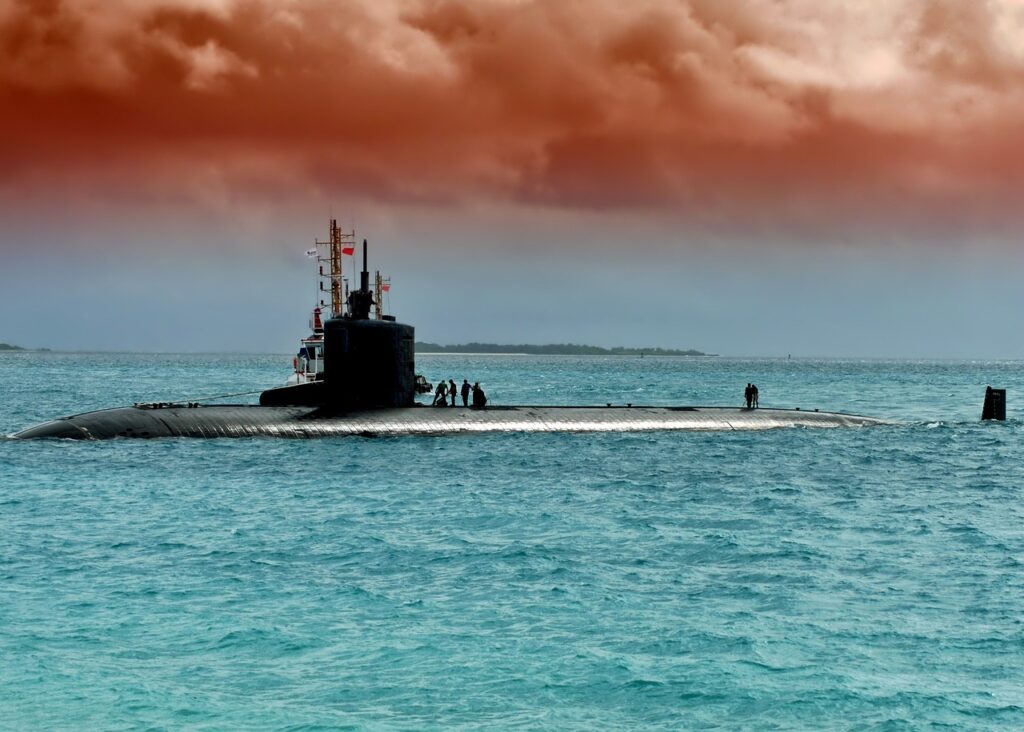- AUKUS is a security partnership between Australia, the UK, and the U.S. focused on developing nuclear-powered submarines and advanced defense technologies. Key initiatives include boosting submarine manufacturing, enhancing electronic warfare capabilities, and expanding Australia’s naval fleet.
- It is noteworthy that AUKUS is still a relatively little-known topic in the U.S. but is a major topic of public conversation in Australia.
- Why it matters: With each passing week, the importance of AUKUS grows. Unlike traditional security pacts, AUKUS gives teeth to the future of how Western allies can stand together.
AUKUS, originally a trilateral security partnership between Australia, the United Kingdom, and the United States, was established in 2021 with a focus on bolstering defense and technological capabilities in the Indo-Pacific region. This partnership centers on two main pillars: acquiring nuclear-powered submarines for Australia (Pillar I) and enhancing advanced defense technologies like cyber, quantum, and artificial intelligence capabilities (Pillar II). AUKUS collaboration includes the establishment of the Submarine Rotational Force-West in Australia by 2027 and the sale of U.S. Virginia-class submarines to Australia in the 2030s. Note that Japan appears poised to join the organization for Pillar II.
Currently, the AUKUS pact is driving several high-profile initiatives, particularly regarding the construction of nuclear-powered submarines for Australia. The Australian government, along with its U.S. and UK counterparts, is investing heavily in its submarine industrial base. Australia has committed approximately AUD 30 billion to bolster its defense industry, which includes creating supply chains and boosting local manufacturing capacity. The UK has also dedicated £4 billion to support the SSN-AUKUS program, while the U.S. has allocated $17.5 billion to strengthen its own submarine industrial base.
In addition to nuclear submarine production, AUKUS is spearheading collaborative innovation in fields such as electronic warfare. In 2024, the first AUKUS Innovation Challenge focused on electronic warfare was launched. This initiative invites defense industries and research institutions from all three nations to develop cutting-edge solutions that improve electronic warfare capabilities. The goal is to ensure all three partners maintain a technological edge against emerging threats.
Training and workforce development are integral to AUKUS’s current activities. For example, more than 40 Australian personnel began training at Pearl Harbor Naval Shipyard in 2024 to develop the skills necessary for maintaining and operating nuclear-powered submarines. This initiative is part of Australia’s broader commitment to developing its Science, Technology, Engineering, and Mathematics (STEM) workforce to support its growing defense capabilities.
The cooperation between AUKUS partners extends to efforts in maintaining interoperability and improving shared industrial capabilities. For instance, Australia’s ASC Pty Ltd and the UK’s BAE Systems are collaborating to bring their extensive experience in submarine building to the SSN-AUKUS program. This partnership aims to build resilience in the supply chains across all three countries and ensure the successful delivery of the submarines by the 2030s.
Australia’s government has unveiled ambitious plans to expand its surface combatant fleet, effectively doubling the size proposed by the previous administration. This expansion responds to Australia’s strategic needs for a larger and more lethal surface combatant fleet, complemented by a conventionally-armed, nuclear-powered submarine fleet. The future fleet will include upgraded air warfare destroyers, new Hunter class frigates, and Large Optionally Crewed Surface Vessels (LOSVs), enhancing the Royal Australian Navy’s capabilities across air defense, long-range strike, and anti-submarine warfare.
The AUKUS partnership, a strategic defense initiative between Australia, the UK, and the US, also represents a significant shift in Australia’s defense posture, emphasizing the transition from conventionally powered to nuclear-powered submarines. This move enhances Australia’s maritime capabilities in response to the evolving security dynamics of the Indo-Pacific region. The agreement necessitates an expansion of Australia’s surface combatant fleet to complement these advanced submarines, underscoring Australia’s commitment to maintaining regional security and stability. Through AUKUS, Australia not only gains access to cutting-edge technology but also strengthens ties with key allies, bolstering collective defense efforts in a strategically vital area.
In July, new UK Defence Secretary John Healey also met with U.S. Secretary of Defense Lloyd Austin to further solidify the defense relationship between the two nations. Healey has offered the new Labour government’s full support to continuing the AUKUS partnership with the U.S. and Australia to build new atomic submarines together in a joint effort to counter China.
AUKUS is not just about military collaboration but also about fortifying defense manufacturing and technological innovation across its member nations. By integrating resources, expertise, and industrial capabilities, AUKUS partners aim to create a stronger, more resilient defense posture in the face of rising global tensions, particularly in the Indo-Pacific.

